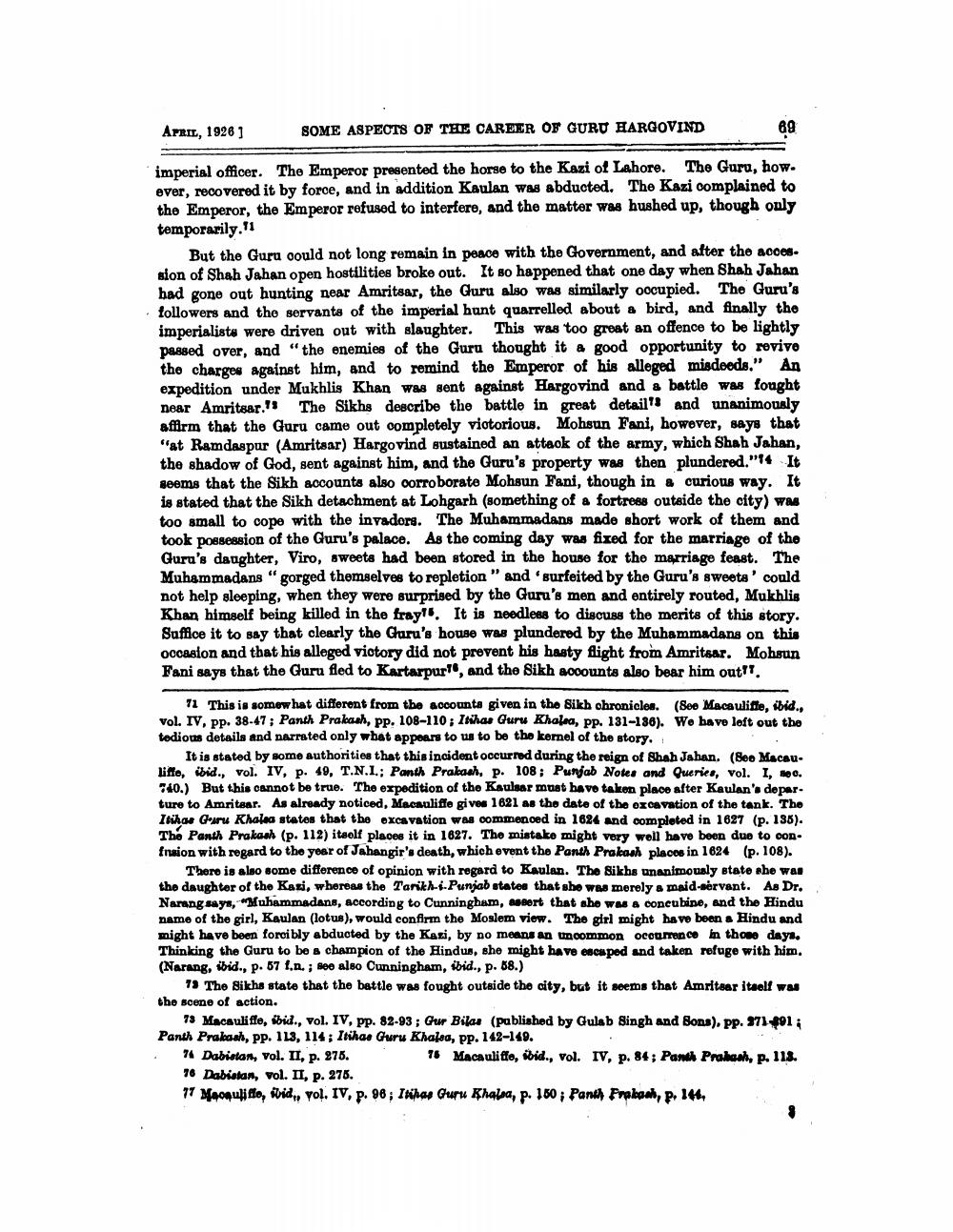________________
APRIL, 1926)
SOME ASPECTS OF THE CAREER OF GURU HARGOVIND
69
imperial officer. The Emperor presented the horse to the Kazi ot Lahore. The Guru, how. ever, recovered it by force, and in addition Kaulan was abducted. The Kazi complained to the Emperor, the Emperor refused to interfere, and the matter was hushed up, though only temporarily."
But the Guru could not long remain in peace with the Government, and after the acces sion of Shah Jahan open hostilities broke out. It so happened that one day when Shah Jahan had gone out hunting near Amritsar, the Guru also was similarly oocupied. The Guru's followers and the servants of the imperial hunt quarrelled about a bird, and finally the imperialists were driven out with slaughter. This was too great an offence to be lightly passed over, and "the enemies of the Guru thought it a good opportunity to revive the charges against him, and to remind the Emperor of his alleged misdeeds." An expedition under Mukhlis Khan was sent against Hargovind and a battle was fought near Amritsar.'s The Sikhs describe the battle in great detail and unanimously affirm that the Guru came out completely viotorious. Mohsun Fani, however, says that "at Ramdaspur (Amritsar) Hargovind sustained an attack of the army, which Shah Jahan, the shadow of God, sent against him, and the Guru's property was then plundered."14 It seems that the Sikh accounts also corroborate Mohsun Fani, though in & curious way. It is stated that the Sikh detachment at Lohgarh (something of a fortress outside the city) was too small to cope with the invadors. The Muhammadans made short work of them and took possession of the Guru's palace. As the coming day was fixed for the marriage of the Guru's daughter, Viro, sweets had been stored in the house for the marriage feast. The Muhammadans "gorged themselves to repletion" and surfeited by the Guru's sweets' could not help sleeping, when they were surprised by the Guru's men and entirely routed, Mukhlis Khan himself being killed in the frayts. It is needless to discuss the merits of this story. Suffice it to say that clearly the Gharu's house was plundered by the Muhammadans on this occasion and that his alleged victory did not prevent his hasty flight from Amritsar. Mohsun Fani says that the Guru fled to Kartarpur", and the Sikh accounts also bear him outil.
71 This is somewhat different from the accounts given in the Sikh chronicles. (See Macaulifte, fbid.. vol. IV, pp. 38-47; Panth Prakash, pp. 108-110; Itihas Guru Khalea, pp. 131-186). We have left out the todioms details and narrated only what appears to us to be tho kernel of the story.
It is stated by some authorities that this incident occurred during the reign of Shah Jahan. (Seo Macaulifto, ibid., vol. IV, p. 49, T.N.I.; Panth Prakash, p. 108; Punjab Notes and Queries, vol. I, 40. 740.) But this cannot be true. The expedition of the Kaulsar must have taken place after Kaulan's depar. ture to Amritsar. As already noticed, Mecauliffe gives 1621 as the date of the excavation of the tank. The Itihar Goru Khaled states that the excavation was commenced in 1624 and completed in 1627 (p. 135). Thó Panth Prakash (p. 112) iteolf places it in 1627. The mistake might very well have been due to confraion with regard to the year of Jahangir's death, which event the Panth Prakash places in 1624 (p. 108).
There is also some difference of opinion with regard to Kaulan. The Sikhs unanimously state she was the daughter of the Kazi, whereas the Tarikh-e-Punjab states that she was merely a maid-servant. As Dr. Narang says, "Muhammadans, according to Cunningham, assert that she was a concubine, and the Hindu name of the girl, Kaulan (lotus), would confirm the Moslem view. The girl might have been a Hindu and might have been forcibly abducted by the Kazi, by no means an uncommon occurrence in those days. Thinking the Guru to be a champion of the Hindus, she might have escaped and taken refuge with him. (Narang, ibid., p. 67 .n.; see also Cunningham, ibid., p. 58.)
79 The Sikhs state that the battle was fought outside the city, but it seems that Amritsar itself was the scene of action.
73 Macauliffe, ibid., vol. IV, pp. 82-93; Gur Bilou (pablished by Gulab Singh and Sons), pp. 371-891 Panth Prakash, pp. 113, 114; Itihar Guru Khalea, pp. 142–149. 74 Dabistan, vol. II, p. 275.
76 MacAuliffo, fbid., vol. IV, p. 84; Panth Praboal, p. 118. 76 Dabistan, vol. II, p. 276. 77 Manuliflo, wid., vol. IV, p. 98; Itihas Guru Khala, p. 160 ; Panth Fralpa, p. 146,




